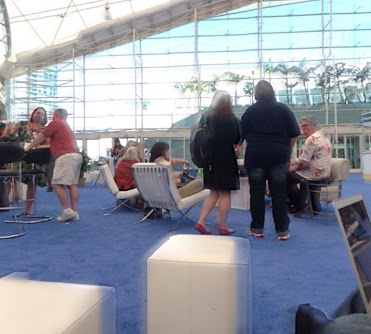Basically, what separates data visualization and infographics is the artist. Data visualization involves a machine (computer,) programmed to take data and show it in a way that makes sense. Spreadsheet generated graphs for example. Infographics involve an artist designing and laying out the same data instead of the machine. The result is the convergence of interest, number crunching and visual design to tell a story. Infographics are a blend of science, math, and storytelling and that's probably why they are popping up all over the internet and in newspapers and magazines. Visual expressions of stories allow readers to grasp complex concepts because they are easy to read.
Infographics can be used in the classroom in several ways:
- Content discovery and study in which students use infographics to grasp concepts. Introduce students to infographics by visiting the website Infographic-A-Day and complete the suggested activities and discussions with your students. The Daily infographic is another website to practice reading and analyzing infographics with your students. **When using infographics with students always look at the source information** as not all infographics are created using verifiable and accurate data. Two thoughts:
1. The power of data visualization is not in the answers the infographic provides but in the power of the questions the infographic generates.
2. Not all infographics created are meant to be read. Some just look really cool.
The History Of The World Infographic is a good example of an infographic that generates questions and looks really cool.
Weight of the world infographic (This requires flash)
Http://newsmap.jp (This requires flash) - Content creation in which students create their own infographics as they make and convey meaning and understanding of essential concepts they are encountering and learning. Communicate "story" and Teach "telling"
Process
- Start with a theme, introduce to students
- Build background
- Focus on one aspect
- Work in groups
- Collaborate
- Research, struggle with the research
- Reflect, final conversation
- Predict what happens next - extend, apply, extend, apply, extend
Creating infographics empowers learners to dynamically create content, especially to uninspired learners.Tools to create Infographics:
- Google's data explorer - google.com/publicdata/explor
- Stephen Abrahms blog - over 100 incredible tools
- Easel.ly online tool
- Visual.ly - lets you create an infographic summarizing your presence online (facebook and twitter.)
- infogr.am - Use a template to create an infographic
- Comic Life - Mac and iPad app for infographic creation and probably the easiest for mac users
- Www.processing.org - Programming language called processing that allows you to create infographics
- Vector graphics - adobe illustrator, inkscape, art board
- Thoughts: Turn science fairs into data fairs via infographic
Other blog posts on infographics :
Lastly - What Is An Infographic? by Infographiclabs 






 Stepping outside of the conference center toward the San Diego Bay and Coranado Island provided the opportunity to capture a bit of southern California sunshine, reflect with others about recent sessions and grab a bite to eat. The entire convention center got me in the mood to learn.
Stepping outside of the conference center toward the San Diego Bay and Coranado Island provided the opportunity to capture a bit of southern California sunshine, reflect with others about recent sessions and grab a bite to eat. The entire convention center got me in the mood to learn.